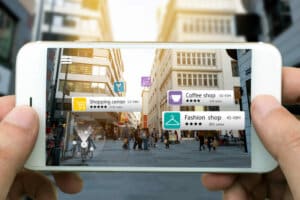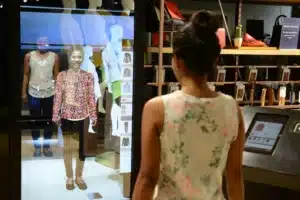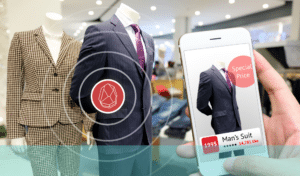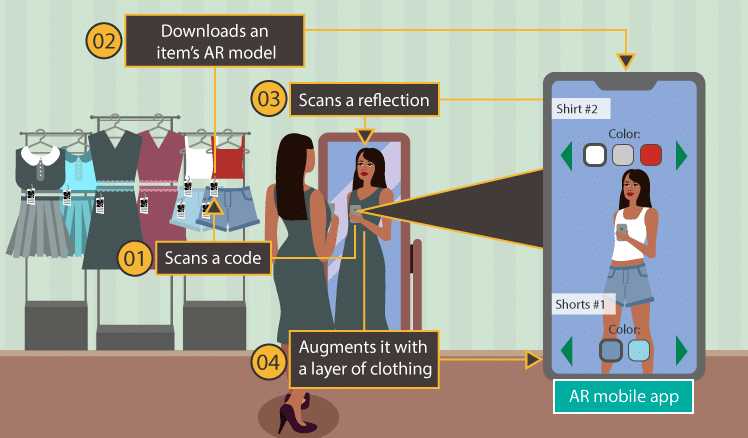Table of Contents
In the ever-evolving landscape of retail, one technology is making a particularly significant impact: Augmented Reality in Retail. This groundbreaking innovation is far more than a technological novelty; it’s a catalyst for transforming the entire retail ecosystem. By seamlessly merging digital elements with the physical world, AR offers a new dimension in consumer experience, fundamentally altering how people shop, interact with products, and engage with brands.
From enabling virtual try-ons to providing real-time product information, Augmented Reality in Retail is enhancing the customer journey in ways that were previously unimaginable. It’s not just about creating visually appealing experiences; AR is also a powerful tool for storytelling and brand engagement. Retailers who adopt this technology are finding that they can captivate consumers in entirely new ways, leading to increased customer loyalty, higher conversion rates, and ultimately, greater revenue.
Moreover, the data analytics capabilities of AR are a boon for retailers. The technology allows businesses to gather detailed insights into consumer behavior, from how long they interact with an AR feature to what products they are more likely to engage with. This data is invaluable for tailoring marketing strategies, optimizing inventory, and even redesigning store layouts.
This article aims to explore the various facets of Augmented Reality in Retail, offering a comprehensive understanding of its current applications, its potential for future growth, and how retailers can leverage AR to gain a competitive edge.
Applications of Augmented Reality in Retail
Augmented Reality in Retail is not a one-size-fits-all solution; its applications are as diverse as the retail industry itself. This section will explore the various ways in which AR is being utilized to enhance both the online and in-store shopping experience.

Virtual Try-Ons: Revolutionizing Fashion Retail
One of the most popular applications of AR in retail is the virtual try-on feature. This allows customers to virtually “wear” clothing, eyewear, or even makeup, providing a realistic preview of how the products will look on them. This feature has proven to be particularly useful for online retailers, reducing return rates and increasing customer satisfaction.
Interactive Product Displays: A New Level of Engagement
In physical stores, interactive product displays enabled by AR can provide customers with instant information, reviews, and even tutorials on how to use a product. This not only enriches the customer’s shopping experience but also aids in making informed purchasing decisions.
Navigation and Wayfinding: Simplifying In-Store Experience
Large retail stores can sometimes be overwhelming for shoppers. AR-enabled navigation and wayfinding systems can guide customers directly to the products they’re looking for, making the shopping experience more efficient and enjoyable.
Personalized Marketing: Tailoring the Customer Experience
AR can also be used for personalized marketing. When customers point their smartphones at a product or a QR code, they can receive personalized offers, recommendations, and discounts, enhancing customer engagement and increasing the likelihood of a sale.
By exploring these diverse applications, it becomes evident that Augmented Reality in Retail is a multifaceted tool capable of transforming various aspects of the retail industry.
Challenges and Considerations: Implementing Augmented Reality in Retail
While the benefits of Augmented Reality in Retail are numerous, it’s crucial to understand the challenges and considerations that come with implementing this technology. This section aims to provide a balanced view, highlighting both the obstacles and the strategies to overcome them.

Cost of Implementation
One of the primary challenges is the cost of implementation. Developing AR features, whether it’s a virtual try-on or an interactive product display, requires a significant investment in both technology and expertise.
User Experience and Usability
Another concern is user experience and usability. Poorly designed AR features can frustrate customers, negating any potential benefits. It’s crucial to focus on intuitive design and seamless integration into existing platforms.
Data Privacy and Security
With the ability to collect vast amounts of consumer data, data privacy and security become paramount. Retailers must ensure they are compliant with data protection regulations and that customer information is securely stored and managed.
Technology Adoption Rates
Finally, the rate at which consumers adopt this new technology is a variable that retailers must consider. While younger demographics may be quick to embrace Augmented Reality in Retail, older consumers may find it more challenging to adapt.
By understanding these challenges and planning accordingly, retailers can more effectively implement AR strategies and maximize the benefits while minimizing the risks.
The Future of Augmented Reality in Retail: What to Expect
As we look ahead, the role of Augmented Reality in Retail is set to evolve further, driven by technological advancements and changing consumer expectations. This section will explore some of the emerging trends and future applications that are likely to shape the industry.

Integration with Other Technologies
One of the most exciting prospects is the integration with other technologies like Artificial Intelligence and the Internet of Things. This could lead to more personalized and context-aware AR experiences, enhancing customer engagement to new heights.
Advancements in Hardware
As AR hardware becomes more advanced and affordable, we can expect to see more in-store applications, such as smart mirrors and AR-enabled point-of-sale systems, that will make the technology more accessible and widespread.
Immersive Shopping Experiences
The concept of immersive shopping experiences is likely to gain traction. Imagine walking into a store and being able to change the ambiance or receive product recommendations based on your mood or past purchases, all enabled by AR.
Sustainability and Ethical Shopping
AR could also play a role in promoting sustainability and ethical shopping by providing consumers with transparent information about product sourcing, materials, and the environmental impact, directly through AR interfaces.
By staying ahead of these trends and continuously adapting, retailers can ensure that they are leveraging the full potential of Augmented Reality in Retail, maintaining a competitive edge in an increasingly digital world.
Real-World Applications of Augmented Reality in Retail
To truly understand the impact of Augmented Reality in Retail, it’s beneficial to look at real-world case studies that demonstrate the technology’s effectiveness. This section will highlight a few examples where AR has been successfully implemented, providing tangible results.

IKEA Place App: Virtual Furniture Placement
One of the most well-known applications of AR in retail is IKEA’s Place App. This app allows users to virtually place furniture in their homes, offering a realistic preview of how different items will fit and look in their living spaces. The app has significantly reduced return rates and increased customer satisfaction.
Sephora’s Virtual Artist: Revolutionizing Makeup Shopping
Sephora’s Virtual Artist app uses AR to allow customers to try on different makeup products virtually. This has not only enhanced the online shopping experience but has also driven in-store sales, as customers can come in with a clearer idea of what they want to purchase.
Walmart’s In-Store Navigation: Enhancing the Shopping Experience
Walmart has implemented an AR-based in-store navigation system that guides customers to the products they’re looking for, making the shopping experience more efficient and enjoyable. This has led to increased customer loyalty and higher in-store sales.
Nike’s Virtual Shoe Trials: A Step Forward
Nike offers a virtual shoe trial feature that lets customers try on shoes virtually, providing a realistic preview of how the shoes will look and fit. This has led to increased conversion rates and a reduction in returns.
These case studies serve as compelling evidence of the transformative power of Augmented Reality in Retail, showcasing its ability to solve real-world problems and enhance the customer experience in meaningful ways.
Conclusion: Augmented Reality in Retail as a Catalyst for Change
In summary, Augmented Reality in Retail is more than just a technological advancement; it’s a transformative force that is redefining the retail landscape. From enhancing customer engagement through virtual try-ons and interactive displays to providing invaluable data-driven insights, AR is proving to be an indispensable tool for modern retailers. While challenges such as cost and data privacy exist, the potential benefits far outweigh the risks. As technology continues to evolve, the applications and impact of AR in retail are bound to expand, offering exciting opportunities for both retailers and consumers.
By embracing Augmented Reality in Retail, businesses can not only meet but exceed customer expectations, setting a new standard for what the retail experience can and should be.









